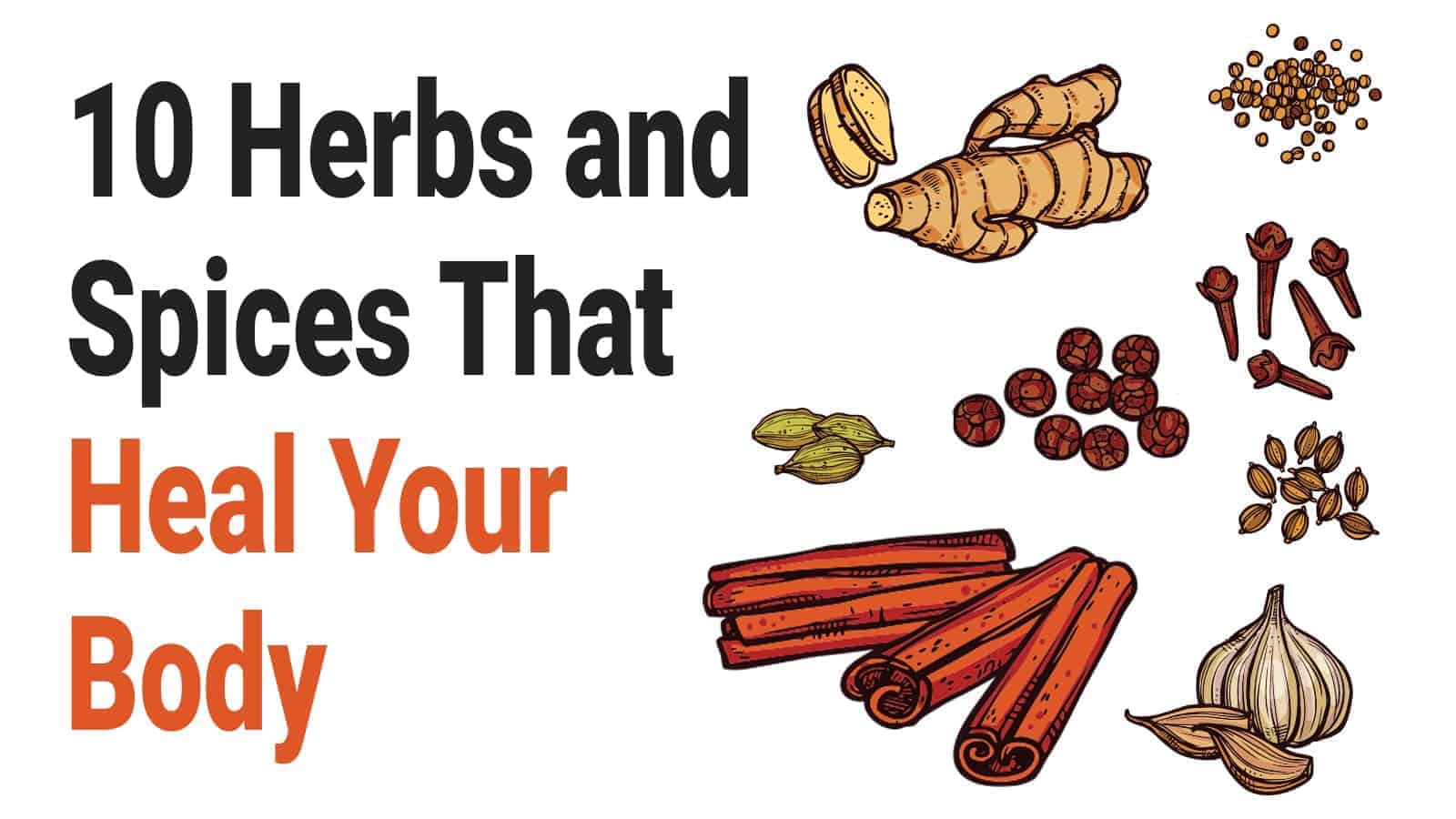Adding spices and herbs that heal your body has been an ever-increasing interest in the United States. This is partly due to the high cost of medications and the realization that current medications have severe side effects that are almost as deadly as what they treat. In addition, since people are living longer, there is increasing interest in preventable measures to promote a higher quality of life in their older years.
The use of herbs and spices in mankind’s history dates back centuries. It pre-dates recorded history. We even have several medications that contain roots from certain herbs and spices. Is it any wonder that we would search out better ways to live by returning to what has been part of our history and that science has been utilizing?
The study of herbs and spices that have healing properties is still in its infancy to verify purity, dosages, and the validity of medicinal claims. There are 10 herbs and spices which have science proves useful to heal the body.
Definition of Herbs Versus Spices
The definition of an herb and a spice can be unclear, and there are some exceptions to the rule.
According to Cambridge Dictionary, an herb “a type of plant with a soft stem” or “a type of plant whose leaves are used in cooking to give flavor to particular dishes or in making medicine.”
According to Cambridge Dictionary, a spice is “a flavoring for food made from part of a plant, such as its fruit, seeds, or root, usually dried and made into a powder.”
It is essential to point out that herbs can be used as a spice and that spices can have medicinal uses. The most important part of each definition is more on the parts of the plants rather than what the plants are used for. It is also possible for the same plant to have one name as an herb and another as a spice. For example, cilantro is considered an herb but its seeds, when ground, are called coriander.
An additional point of interest is how the definition of an herb specifies that the leaves are used in cooking to give flavor or make medicine. When used for medicinal purposes, a plant is not limited to the leaves. Instead, any part of the plant may be used and individual parts of the same plant may have different benefits, or even be toxic.
History of Herbs and Spices
One of the oldest known ingredients for “flavor enhancement and preservation” is salt. It dates back in recorded history as far as 6,050 BC. Likely, salt was used even before this. Salt played a crucial role in mankind’s desire to trade; it also found use as a currency in many parts of the early world. Yet, salt is not a spice. It’s a mineral. However, with the salt-inspired trade came the discovery of other spices and herbs in various parts of the world.
As far back as 3,500 BC, ancient Egyptians used spices for cosmetics, food flavoring, and embalming the dead. The oldest written evidence of plants used for medicine is on a Sumerian clay slab from Nagpur about 5,000 years ago. This slab had the recipes for 12 different medications with over 250 plants used in the preparation.
From then on, there are multiple references to herbs and spices being used for medicinal uses, a form of currency, in negotiations for territories, in religious books, and more. It was not until the early 19th century that there was a change in the knowledge and use of medicinal plants with the growing aid of science.
Current Medicines Based on Herbs and Spices
While we often distinguish herbal medicine from traditional medications, many current prescribed medications come from herbs. Such as:
- Morphine came from seed pods of the poppy
- Penicillin from bread mold
- Digoxin, a cardiac stimulant, came from foxglove
- Salicylic acid, a precursor to aspirin, came from willow bark
- 60% of all cancer therapeutics on the market or in testing are plant-based
- 70% of the 177 drugs used to treat cancer are based on natural products and then improved with other chemistry.
It is estimated that about 25% of the drugs prescribed worldwide were derived from plants and about 121 such active compounds are in use.
Herbs and Spices that Heal the Body
Turmeric:
Curcumin is the active ingredient found in turmeric. It has been recognized as a powerful antioxidant, anti-inflammatory, and digestive aid. Indeed, some studies state it may even treat or prevent Alzheimer’s disease.
Ginger:
There are hundreds of compounds in ginger that create various benefits. This spice has long been recognized for its beneficial effects in treating nausea, but it also has digestive benefits, antioxidants, and mild anti-inflammatory effects related to joint pain. Some studies show its potential use for preventing and treating cardiovascular disorders; it helps relax blood vessels and stimulate blood flow.
Black Pepper:
Recognized to reduce cholesterol, have antioxidant properties, and reduce inflammation.
Cinnamon:
One of the oldest spices and among the most used. It has been proven that half of a teaspoon to 2 teaspoons a day can reduce blood sugar by 20% in diabetics. It aids in the reduction of cholesterol and digestion and can provoke blood flow while reducing peripheral vascular resistance, making it great for your circulation.
Coriander:
The seeds of the cilantro plant, coriander, may treat diabetes and cholesterol. There are also some studies in regard to it being used to reduce platelet aggression.
Rosemary:
Aids reduces allergy reactions in the nose and sinus congestion and acts as an antioxidant. Also, some evidence shows that the smell of it can boost brain function.
Garlic:
Probably one of the most used plants in cooking, garlic has an ingredient called allicin. This contributes to both its pungent odor and its health benefits. Evidence links garlic to increased cardiovascular health, lower cholesterol (possibly up to 9%), and a 5% reduction in blood pressure. It is also an antioxidant and has antibacterial effects. Additionally, several studies point to various benefits related to blood anti-clotting and reducing cholesterol from the arterial walls.
Cayenne Pepper:
This spice has been used in ointments targeted toward arthritis through the active ingredient capsaicin. It creates a warming or thermal heating from the body. Thus, it aids in reducing joint pain, increasing fat burning, and decreasing appetite. Sadly, if you are accustomed to eating hot peppers, it loses its effectiveness; your body can build a tolerance to it.
Clove:
This little seed is used to prevent or relieve gas build up, increase hydrochloric acid in the stomach, which aids in digestion, fight acid reflux, and help to absorb B12, calcium, iron, and protein. Additionally, some dentists use its essential oil form as a pain killer in emergencies.
Thyme:
Traditional healers used thyme treating respiratory infections such as bronchitis. It reduces mucus production and coughing and has proven to inhibit bacterial growth.
Americans now take a keen interest in herbal solutions. Thus, it is important to understand why it is taking science so long to “approve” their use:
- Isolating the active ingredient(s) and from which part of the plant.
- Isolating an effective dosage.
- Determining the survival of active ingredients through our digestive enzymes.
- Determining the most effective form for each benefit; essential oil, pill, tea, cream, crushed, ground, whole leaf, etc.
- Deciding if it requires a second or third treatment for best results.
- Determining longevity and conditions for the lifespan.
The future potential of returning to the more natural use of spices and herbs in treating or preventing mankind’s various health issues looks great. However, not everything you read regarding the benefits of herbs or spices has been verified.

Final Thoughts on Using Herbs for Better Health
Be sure to research science or medical reports before taking any herbal supplement. This saves money and the potential toxicity from wrong dosages or irresponsible marketing making false statements. Many of these herbs or spices, when used medicinally, can create an unfavorable interaction if you are currently on medications. Use any natural remedies with caution and under the supervision of a medical professional. If you aren’t taking medications, the above-listed spices and herbs are generally safe in recipes or as stand-alone health remedies.


















